Consider pulling a Civil War pension file from the National Archives in Washington D.C. – a gold mine of information could be waiting for you.
The effort to get copies of the records is well worth it, as I discovered recently while researching a Civil War veteran from Kentucky. 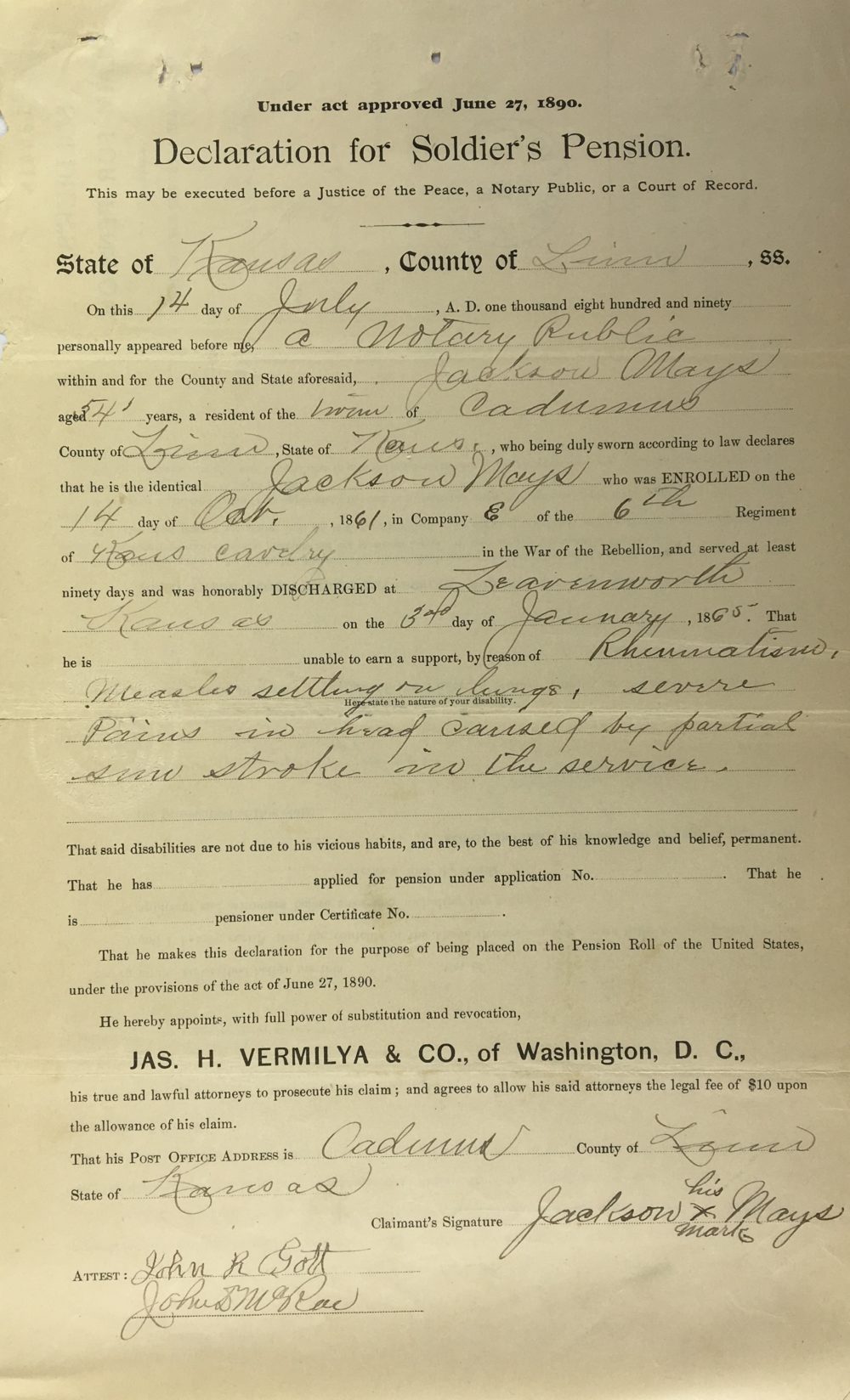
A few months before his death, a the veteran applied for an invalid pension in 1887. At the time of his application he was suffering from late stages of cancer and was in a very desperate situation. Most likely his decision to apply for a pension was to safe guard a future source of income for his wife who was advanced in years.
For his descendants, his application left behind a record offering a rich source of first hand information of his life story. Such things any family historian or genealogist would go giddy over.
The veteran was required to present evidence his health problems had come about from his military service. After his death, the veteran’s widow had to prove she was his lawful wife in order to be entitled to his pension payments.
To make his case the veteran included a wide range of eye witness accounts providing a wealth of information such as the veteran’s physical characteristics, occupation, level of literacy, military service history including a court martial hearing, information on family members, financial situation, death bed confessions, and vital dates for his birth, marriage, and death.
The vital dates were particularly important as no known documentation exists of these important life events. A number of witness affidavits provided details and information not found in more common records.
For example, the circumstances of his marriage was described in great detail. The veteran and his bride eloped to Ohio to avoid Kentucky marriage bonds. Borrowing a horse and money from a store merchant in their community, they went to Aberdeen Ohio where they were married by a justice of the peace. On their return home, rumors began to spread in the community the couple were living in sin. In response, the newly weds had their marriage certificate read in front of many witnesses at a community store to quell all rumors regarding their status as a married couple. Such details would never have been found in a traditional marriage record.
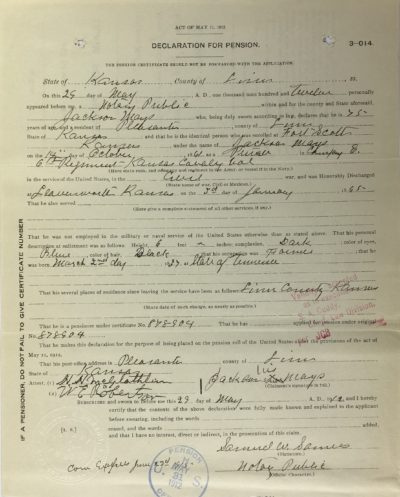
The maiden name of the wife was given, as well as the name of the justice of the peace who married the couple. The officer’s name provided a clue to where the marriage was actually recorded. Not found in civil registrations, but in the personal marriage recordings of the peace officer, the marriage registration confirmed the marriage date given in the affidavit testimonies in the pension file.
The veteran’s health complications and circumstances of his death were described in great detail. Such descriptions would never have been found in a typical death record. More importantly you get a straight forward account of the soldier’s suffering and a sense of his humanity.
Specifics of the veteran’s military service were also recorded adding facts which cannot be found in his military service records. For example, after being jailed by military authorities in his hometown, the veteran escaped and returned to his battery unit still wearing leg irons. Thus the veteran’s Civil War experience was enhanced substantially by what was recorded in the pension file.
Without the witness affidavits given in the pension file, many biographical details of the veteran found would never have come to light and remained hidden.
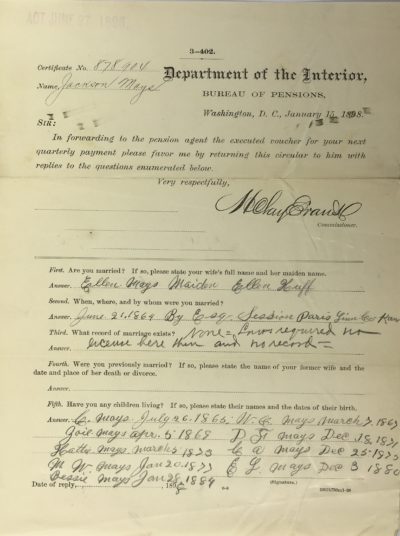
Jackson Mays – marriage and children
Pension files can potentially provide key evidence of specific life events and family information not found in other sources.
For example, my ancestor, Andrew Jackson Mays, in his pension file supplied the date of his marriage, his wife’s maiden name and the person who married him. This marriage record most likely was never officially recorded. Mays also listed nine of his children and their birth dates.
By the nature of the pension application process, where a soldier or widow of a soldier must make arguments for eligibility of a pension, you can even get a sense of what they were feeling and what was on their mind.
How to Organize all those images!
I recommend obtaining images of the documents, which is quite easy to do given the technology we have available to us. Most cell phones today capture fantastic images.
Digital images reflect the true nature of the documents such as the original color for example and are easier to read versus a black and white copy. Digitization allows you to magnify a record to see the fine details and assist in reading the original hand writing. Images will help you save time and the cost of photocopying. With images, you can share with others, post them on-line, and store them in a number of safe places, all things a photocopy cannot do.
Be prepared, a pension file can hold a large number of documents. The Kentucky veteran’s file I described previously consisted of over a hundred images. With so many documents it can be extremely difficult and an overwhelming task to sort thru all the information . Here are some helpful suggestions on how to organize the vast amount of information you might encounter:
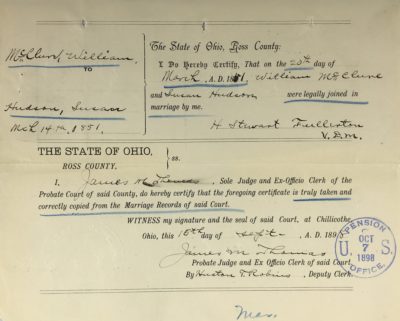
A marriage record found in a pension file.
1. Most of the records are hand written and require transcribing the information allowing for easier reading. Transcription saves time as you will not have to continually decipher difficult handwriting and will assist you in organizing the information.
2. Many of the records in the files are not in chronological order and one document can have a number of different dates. Therefore organizing the information becomes critical to make sense of the details and the pension process.
3. The method I use is to assign a number to each image, record the title of the document, the primary date, and the principle person involved. Then, using a word processing program, I transcribe word for word the information found in that record. Many of the forms in a pension file have redundant information or legal phrases and many of the records are formal forms which you can then abstract if you like. While you are doing this, you can create a source citation which you can then copy and past into a research report or narrative.
4. Each time I transcribe a record, I will create an Excell spreadsheet to organize the information keeping in mind how I might sort the data when I am ready to build a narrative of the individual. Possible column headings to consider are:
Image #
Document date
Last Name of key person
First Name of key person
Type of information such as birth, death, military, description etc.
Source citation
Notes
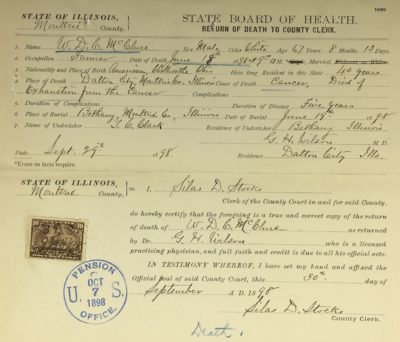
A death record found in a pension file.
These categories will help to sort the information by person, date, or type of information. Many times a single witness can provide a number of affidavits at different times, so sorting by person can be helpful. The image number is useful as it will allow you to find a particular image very quickly if you want to use it sometime in the future.
You have the flexibility to design your sheet to best fit your needs but, most important you save time and avoid extra effort.